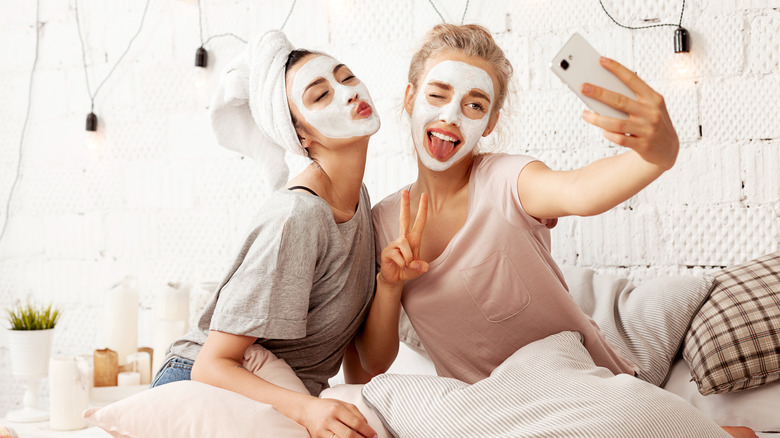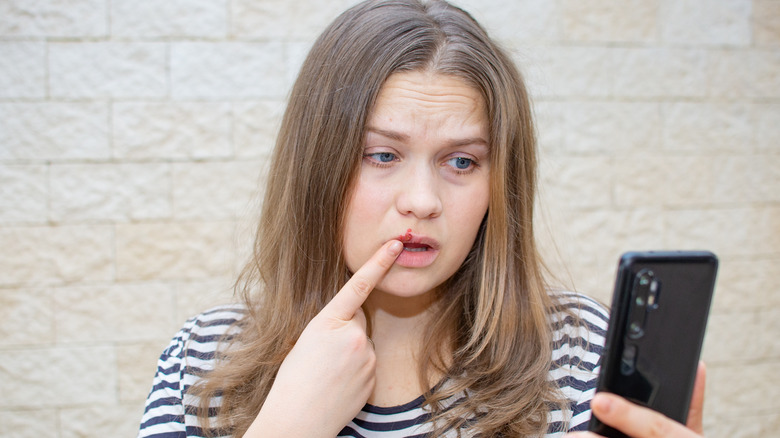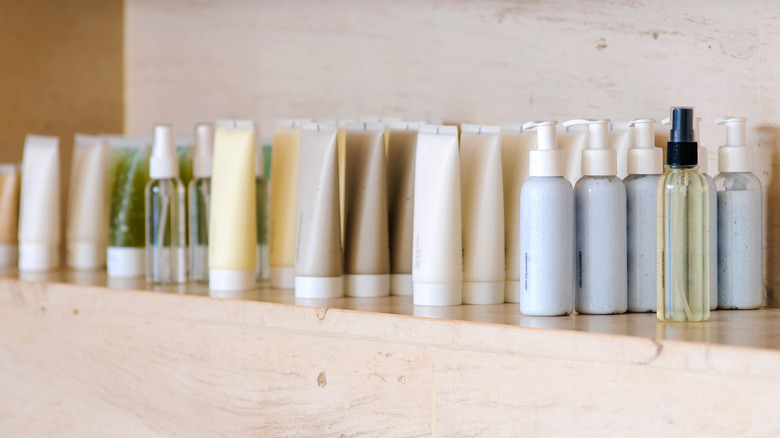SkinTok May Be Sabotaging Your Mental Well-Being. Here's How To Step Away
Taking care of your skin is important — after all, it's your body's largest organ and biggest protector against microbes, bacteria, and intrusive elements, according to WebMD. It's also the most visible organ since it literally covers everything from head to toe. Prioritizing caring for your skin is a responsible thing to do, but modern care of skin has become synonymous with optimizing visible aspects of skin — particularly on the face — with the pricey products marketed on social media platforms. In fact, the promotion of skincare products for acne, redness, oil, and other bothersome appearances on the face has become one of the most popular topics consumed by users on TikTok, which has aptly been termed SkinTok.
From face masks as a form of self-care to serums said to fight acne while hydrating skin, the skincare corner of TikTok and other social media platforms is growing. The increase in interest by users is believed to come from a desire to correct skin conditions that are associated with imperfections meant to be eradicated, especially by means of single products promoted as magic solutions to respective skin concerns. Before-and-after photos of skin transformations also abound.
But persistent consumption of content telling people how imperfect their skin is and trying to persuade them to purchase costly products can take a big toll on the mental wellness of users. Here's how SkinTok and its microtrends can cause your mental health to suffer and how you can step away from them while regaining your well-being.
Mind the impact of exclusionary skincare videos
It may sound counterintuitive, given skincare content often underscores self-care, but constantly consuming skincare content can actually harm your mental health. This is particularly true for content that shows before-and-after photos or portrays subjects with flawless skin, which can often be attributed to filters and photo-altering software rather than real images. Within SkinTok are microtrends like CleanGirlTok and the "clean girl aesthetic," which can be very problematic for your mind, reports PureWow. These trends frequently focus on highlighting white women who can afford expensive, lavish products. While CleanGirlTok emphasizes minimizing skincare routines and prioritizing clean, fresh skin, it has quickly evolved into a virtual environment of appropriation, exclusion, ageism, ableism, and fatphobia. In many SkinTok microtrends, BIPOC and LGBTQIA+ users are excluded.
When content spotlights young, thin, able-bodied, cis women with naturally clear skin, users who don't fit these narrow criteria are prone to internalizing the negative impacts of SkinTok's unspoken messages, which convey that if you aren't the perfect candidate of privilege, then you aren't adequate — nor is your skin. As content inundates users with reminders of imperfections, mental wellness can erode; Cleure emphasizes the conscious awareness it takes to merely identify that our mental health is being affected by skin-related issues. If you notice you're becoming negatively affected, try journaling, speaking with friends, mindfulness techniques, or CBT therapy to process those feelings rather than doubling down on content that encourages "fixing your skin" as the answer to being your best self.
Ditch comparison for encouragement
A common quote reads, "Don't compare your behind-the-scenes to everyone else's highlight reel." People usually restrict their social media content to media making them look their best, something now easier than ever with filters and alteration features on most platforms. For SkinTok, the quote couldn't be more applicable. Watching videos of people with seemingly flawless skin, being promised extraordinary results with the use of single yet very expensive products, and viewing purported before-and-after timelapses can take a toll on mental health through constant comparison of your skin with that of influencers on TikTok. Particularly when the costly items sworn to cure all of your skin woes don't produce the results on your skin that others claim they've experienced, skin comparison can follow you offline and bring anxious and insecure thoughts about your skin's appearance.
TikTok's fast-paced clips instigate dopamine production, leading users to seek more content as they scroll. Dr. David Barhart, a clinical mental health counselor, tells WAFF48 that users "begin to get this view of themselves in comparison to other people, and the more of that we see, the more distorted our view of what it's like to be the best, to be good." Users are inclined to experience unhealthy obsessions with fitness, exercise, and appearance, including hyper-fixating on perceived flaws. The easiest way to cut down on the constant SkinTok scrolling that's damaging your wellness is to make plans with people IRL, so text your BFF who you know will hype you up!
Fight cost and clutter of excessive skincare
Between the cost-of-living crisis, inflation, and adulting, the exorbitant prices of skincare products may not sit well with your wallet — the price tags on many skincare products may even cost more than some bills. SkinStore conducted a survey of 3,000 participants to determine how much people actually spend on products for their skin; the results found the mean daily amount spent on skincare products is $8, meaning that the average American woman spends about $240 on skincare per month and nearly $3,000 annually. Survey participants also reported an average of 16 steps in their skincare routines. Having so many products on your countertop can easily create clutter, and that's not even including hygiene items like toothbrushes, toothpaste, and deodorant. Grabbing all of SkinTok's must-haves can leave you struggling to manage mountains of products in a limited space.
Northwestern Medicine recommends minimizing your skincare routine and finding core products that work for your skin, taking into account periods of hormonal fluctuations like pregnancy and menopause. Consider the environment around you, since living with harsh, cold wind that dries skin is different from hot, humid climates that provoke sweat-induced acne. Like topical medications, your skin absorbs products you put on your face, so minimizing your routine and looking for clean ingredients are key — and you're less likely to go down a SkinTok rabbit hole looking for the latest finds if you're happy with the affordable products and pared-down routine you already have.
Creating a budget can curb the pressure to spend
Affording skincare products on an annual basis practically equals having to budget for a 13th month of the year, especially if you're anywhere near the $3,000 average on skincare products each year. Purdue University reports that financial stress, which can stem from overspending or straining to make essential payments, is closely linked to both mental well-being and physical health; with financial difficulties can come increased blood pressure, intense headaches, gastrointestinal issues, muscle tension, and lower immune health. The stress component can coincide with anxiety, depression, and overwhelm over financial wellness.
SkinTok can pressure you to splurge on the latest skincare products, but if you can't bear to look away from the trends, you can still take steps to shield yourself from financial stress. Create a monthly budget for your skincare and makeup needs, first totaling the cost of your core skincare products like cleanser, toner, moisturizer, exfoliant, and sunscreen. Your budget should have set limits you can reasonably afford and stick to, knowing you can be savvy with sales and coupons. After deducting the cost of core products, calculate second-tier items like cosmetics, hair products, and spa treatments. Use any remaining funds in your beauty budget to purchase special-use items or something you've been wanting to try. When you're committed to sticking to your budget, you might find yourself thinking twice about an expensive product you've had to save up for — and less inclined to view content tempting you to spend.
Ease skin anxiety with self-love
Skin anxiety, much like other forms of anxiety, is rooted in fear, insecurity, and obsessive behaviors geared toward comparison and feeling less than others. Unlike other forms of anxiety, skin anxiety has an underlying cause of manipulation and intentional design to make consumers of skincare advertisements and marketing — including SkinTok videos — feel like they need to change their skin to be worthy, according to a 2020 book by Martha Laham titled, "Made Up: How the Beauty Industry Manipulates, Consumers, Preys on Women's Insecurities, and Promotes Unattainable Beauty Standards."
Laham describes how cosmetic company executives have used similar tactics for decades to make consumers believe they can achieve flawless skin through the purchase of their products. The consumption of this intentional marketing can lead to the feeling that your skin is imperfect and flawed, which can lead to hyperfixation on perceived flaws and obsession with correcting them.
When experiencing an acne breakout, users are significantly less likely to sign on to social media, according to a 2017 survey by Cutanea Life Sciences, Inc. Nearly all survey responses indicated concerns and negative fixations on acne. In addition to staying away from content that focuses on eradicating acne and other "flaws," Healthline reports that positive self-talk techniques and the use of affirmations, personalizing them with self-love, can go a long way toward easing this skin anxiety. When you begin to feel the pressure from SkinTok — whether you're currently watching videos or not — say your affirmation to yourself.
Regulate your skincare content consumption
While it's easy enough to say you could remove the source of skin anxiety and other related stress by deleting TikTok and other social media apps, realistically, this won't completely shield you from the pressure to get perfect skin (and may leave you with some FOMO anxiety as well).
Rather than cutting yourself off completely, make a plan to regulate how much you consume social media, especially SkinTok videos — instead, fill that time with in-person interactions that are likely to leave you feeling uplifted and more fulfilled. One simple change you can make with your TikTok usage is to engage in activities that make you feel good about yourself before you begin scrolling. This practice can have immensely positive effects on how you feel during and after scrolling your feed.
And while it's not a failsafe, you can also cut down on the amount of negative content you see by how you engage with it. TikTok wants to keep you on the app by showing you things it thinks you like. If you spend less time looking for skincare content, and if you stop viewing a video or even tell your app you're not interested in similar content when you see skincare videos that make you feel bad, you're less likely to see toxic skincare content flooding your feed. Surround yourself with uplifting things online and off, and you might find that SkinTok and its negative messages have less appeal and presence in your life.





